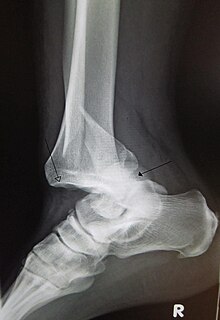
Back خلع المفصل Arabic Изкълчване Bulgarian পূর্ণচ্যুতি Bengali/Bangla Luxació Catalan Táuk-lùng CDO Vykloubení Czech Luxation German Εξάρθρωση Greek Luksacio Esperanto Luxación Spanish
This article needs more reliable medical references for verification or relies too heavily on primary sources. (January 2022) |  |
| Joint dislocation | |
|---|---|
| Other names | Latin: luxatio |
 | |
| A traumatic dislocation of the tibiotarsal joint of the ankle with distal fibular fracture. Open arrow marks the tibia and the closed arrow marks the talus. | |
| Specialty | Orthopedic surgery |
A joint dislocation, also called luxation, occurs when there is an abnormal separation in the joint, where two or more bones meet.[1] A partial dislocation is referred to as a subluxation. Dislocations are often caused by sudden trauma on the joint like an impact or fall. A joint dislocation can cause damage to the surrounding ligaments, tendons, muscles, and nerves.[2] Dislocations can occur in any major joint (shoulder, knees, etc.) or minor joint (toes, fingers, etc.). The most common joint dislocation is a shoulder dislocation.[1]
Treatment for joint dislocation is usually by closed reduction, that is, skilled manipulation to return the bones to their normal position. Reduction should only be performed by trained medical professionals, because it can cause injury to soft tissue and/or the nerves and vascular structures around the dislocation.[3]
- ^ a b Dislocations. Lucile Packard Children’s Hospital at Stanford. Retrieved 3 March 2013. [1] Archived 28 May 2013 at the Wayback Machine
- ^ Smith, R. L., & Brunolli, J. J. (1990). Shoulder kinesthesia after anterior glenohumeral joint dislocation. Journal of Orthopaedic & Sports Physical Therapy, 11(11), 507–513.
- ^ Skelley NW, McCormick JJ, Smith MV (May 2014). "In-game Management of Common Joint Dislocations". Sports Health. 6 (3): 246–255. doi:10.1177/1941738113499721. PMC 4000468. PMID 24790695.